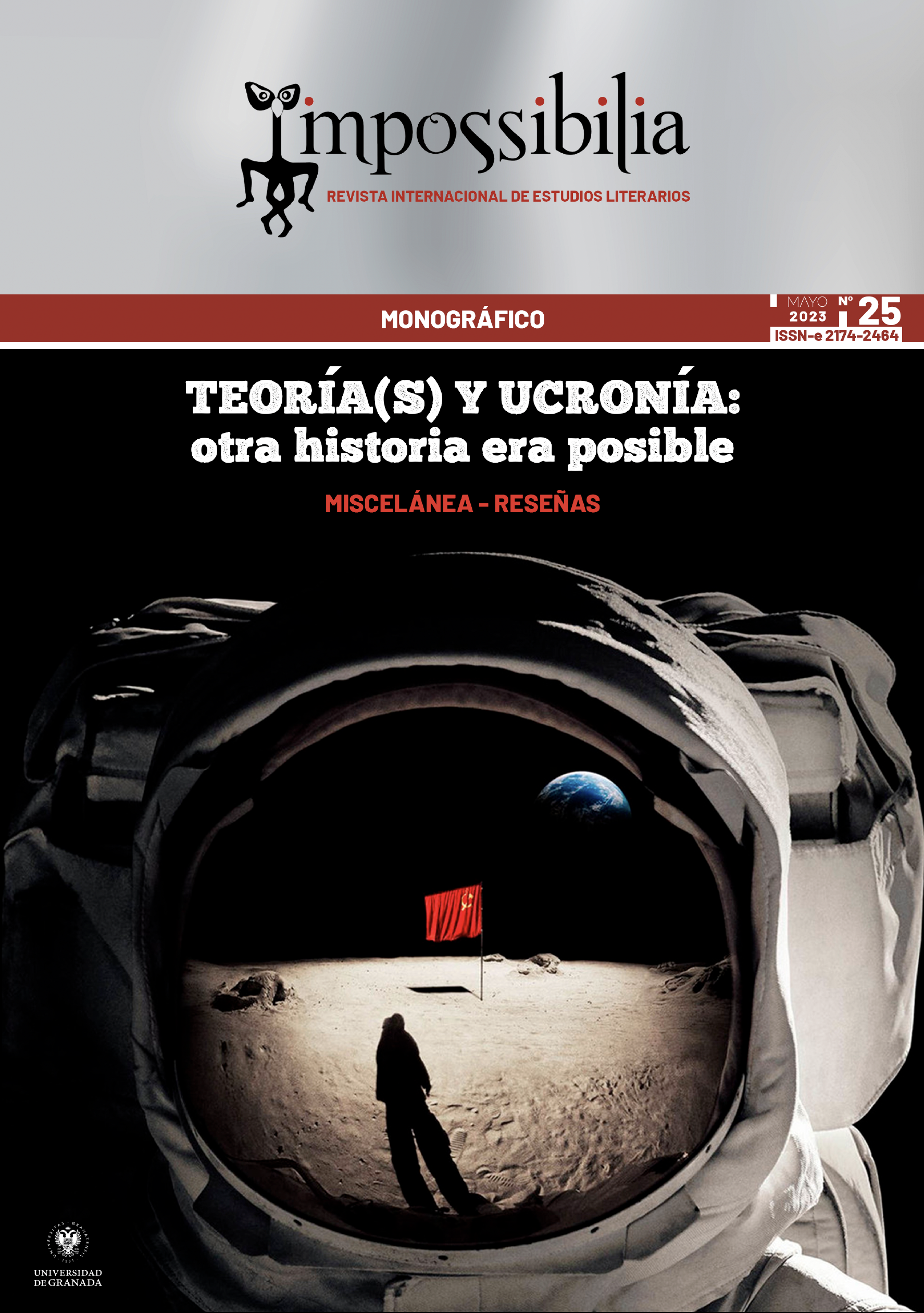Theatre and uchronia in 19th Century Spain
DOI:
https://doi.org/10.30827/impossibilia.252023.26592Keywords:
Uchronia, theatre, 19th Century, liberalism, historical drama.Abstract
This article focuses on the role played by uchronia in the 19th Century Spanish theatre. Difficulties in nation-building process, due to social and political unrest, were underwent with anxiety. Within the liberalism causes of that failure were looked for in the past. Middle Ages were idealized as a period of freedom, broken by the religious intolerance and the political absolutism. Theatre in that century was one of the main places to leisure, but also to educate people. A liberal speech was displayed there from the historical plays. Many of them looked backward to the past, suggesting an alternate history where loads of mistakes throughout the historical development of the country were overcome.
Downloads
References
ÁLVAREZ BARRIENTOS, Joaquín. (2019). El actor borbónico. Madrid: Asociación de directores de Escena.
ALVAREZ CIENFUEGOS, Nicasio. (1815). La Condesa de Castilla. Tragedia nueva en tres actos. [s. n].
ÁLVAREZ JUNCO, José. (2001). Máter dolorosa. La idea de España en el siglo XIX. Madrid: Taurus.
ANDREU MIRALLES, Xavier. (2013). L´Espagne c´est encore l´orient, pasado oriental y moral cristiana en Martínez de la Rosa. En ARCHILÉS, Ferrán, GARCÍA CARRIÓN, Marta y SAZ, Ismael. (eds.). Nación y nacionalización: una perspectiva europea comparada (pp. 171-199). Valencia: Universidad de Valencia.
ARCHILÉS, Ferrán. (2011). Melancólico bucle. Narrativas de la nación fracasada. En SAZ, Ismael y ARCHILÉS, Ferrán. (eds.). Estudios sobre nacionalismo y nación en la España contemporánea (pp. 245-330). Zaragoza: Prensas Universitarias de Zaragoza.
ASQUERINO, Eusebio. (1851). Españoles sobre todo. Madrid: Vicente de Lalama.
BALAGUER, Víctor. (1847). Juan de Padilla. Madrid: Vicente de Lalama.
BENJAMIN, Walter. (1990). El origen del drama barroco alemán. Madrid: Taurus.
CALDERA, Ermanno. (2001). El teatro español en la época Romántica. Madrid: Castalia.
DUVERINE, A. (1840). Cuadro histórico de las clases y espíritu de reforma política en España. Madrid: Boix.
EVANS, Richard. (2014). Altered Pasts. London: Little Brown.
FERGUSON, Niall. (1997). Introduction. Towards a ‘Chaotic’ Theory of the Past. En FERGUSON, Niall. (ed.). Virtual History: Alternatives and Counterfactuals (pp. 1-90). New York: Basic Books.
GALLAGHER, Catherine. (2018). Telling It Like It Wasn´t. Chicago: The University of Chicago Press.
GIES, David. (1996). El teatro en la España del siglo XIX. Cambridge: Cambridge University Press.
GIL y ZÁRATE, Antonio. (1841). Carlos II el hechizado. Madrid: Repullés.
HARTOG, François. (2003). Régimes d´historicité. Présentisme et expériences du temp. Paris: Éditions du Seuil.
HELLEKSON, Karen. (2013). The Alternate History. Refiguring Historical Time. Playing with Contingency and Necessity. Boston: Walter de Gruyter.
JOVELLANOS, Gaspar Melchor. (1812). Memoria sobre las diversiones públicas, escrita por D. Gaspar Melchor de Jovellanos, académico de número, y leída en junta pública de la Real Academia de la Historia el 11 de julio de 1796. Madrid: Imprenta de Sancha.
KAYE, Simon. (2010). Challenging Certainty: The Utility and History of Counterfactualism. History and Theory, 49 (1), 38-57.
LABANYI, Jo. (2013). Love, Politics and the Making of the Modern European Subject: Spanish Romanticism and the Arab World. Hispanic Research Journal, 5(3), 229-243. https://doi.org/10.1179/hrj.2004.5.3.229
LEVINGER, Matthew & LYTLE, Paula. (2001). Myth and mobilisation: the triadic structure of nationalist rhetoric. Nations and Nationalism, 7(2), 175-194.
LÓPEZ VELA, Roberto. (2004). De Numancia a Zaragoza. La construcción del pasado nacional en las historias españolas del Ochocientos. En GARCÍA CÁRCEL, Ricardo. (coord.). La construcción de las Historias de España (pp. 195-298). Madrid: Marcial Pons.
MANZANO Y OLIVER, Francisco. (1859). Pizarro el Conquistador. Madrid: Vicente Lalama.
MARTINEZ DE LA ROSA, Francisco. (1820). La viuda de Padilla. Valencia: Domingo y Bompié.
MARTÍNEZ DE LA ROSA, Francisco. (1971). Apuntes sobre el drama histórico. En NAVAS RUIZ, Ricardo. El Romanticismo español: documentos (pp. 282-289). Salamanca: Anaya.
MARTÍNEZ DE LA ROSA, Francisco. (1861). Aben Humeya o la rebelión de los moriscos. En Obras dramáticas de D. Fco Martínez de la Rosa Vol. II (pp. 93-183). Madrid: M. Rivadeneyra.
McCLINTOCK, Anne. (1995). Imperial Leather. Race, Gender, and Sexuality in the Colonial Context. New York: Routledge.
PENAS VARELA, Ermita. (2003). El drama romántico. En HUERTA CALVO, Rafael (dir.). Historia del teatro español Vol. II (pp. 1895-1941). Madrid: Gredos.
PEYROU, Florencia. (2019). A vueltas con las dos esferas. Una revisión historiográfica. Historia y Política 42, 359-385. https://doi.org/10.18042/hp.42.13
PI y MARGALL, Francisco. (1851). Historia de la pintura en España. Madrid: Manini Hermanos.
RENOUVIER, Charles. (2019). Uchronie (l´utopie dans l´histoire). Madrid: Akal.
RIBAO, Montserrat. (1999). Textos y representación del drama histórico en el Romanticismo español. Pamplona: EUNSA.
RODRÍGUEZ RUBÍ, Tomás. (1850). Isabel La Católica. Madrid: S. Omaña.
SAAVEDRA, Ángel, Duque de Rivas. (1822). Lanuza. Madrid: Luis Muñoz y Vilches.
SÁNCHEZ, Raquel. (2007). España y los españoles en la obra de Zorrilla. Historia y Política, 17, 205-222.
TORRECILLA, Jesús. (2016). España al revés. Los mitos del pensamiento progresista (1790-1840). Madrid: Marcial Pons.
ZAPATA, Marcos. (1901). La capilla de Lanuza. Madrid: R. Velasco.
ZORRILLA, José. (1876). El zapatero y el rey. Madrid: Policarpo López.
Published
How to Cite
Issue
Section
License
Copyright (c) 2023 Impossibilia. Revista Internacional de Estudios Literarios

This work is licensed under a Creative Commons Attribution-NonCommercial-NoDerivatives 4.0 International License.

You are free to share, copy and redistribute the material in any medium or format under the following terms: You must give appropriate credit, you may not use the material for commercial purposes and No Derivatives. Commits to respecting third party intellectual property rights.
Reception and proccesing of papers has no costs for authors.
Author assumes responsibility for the ideas contained in the article.
Papers must be original and must not have been published before and at the moment they are submitted, papers should not be in the process of evaluation by any other electronic or printed media.
The authors are allowed and recommended to publish their published work through the internet. It could produced interesting exchanges and increase the published work citation. (See El efecto del acceso abierto).




















